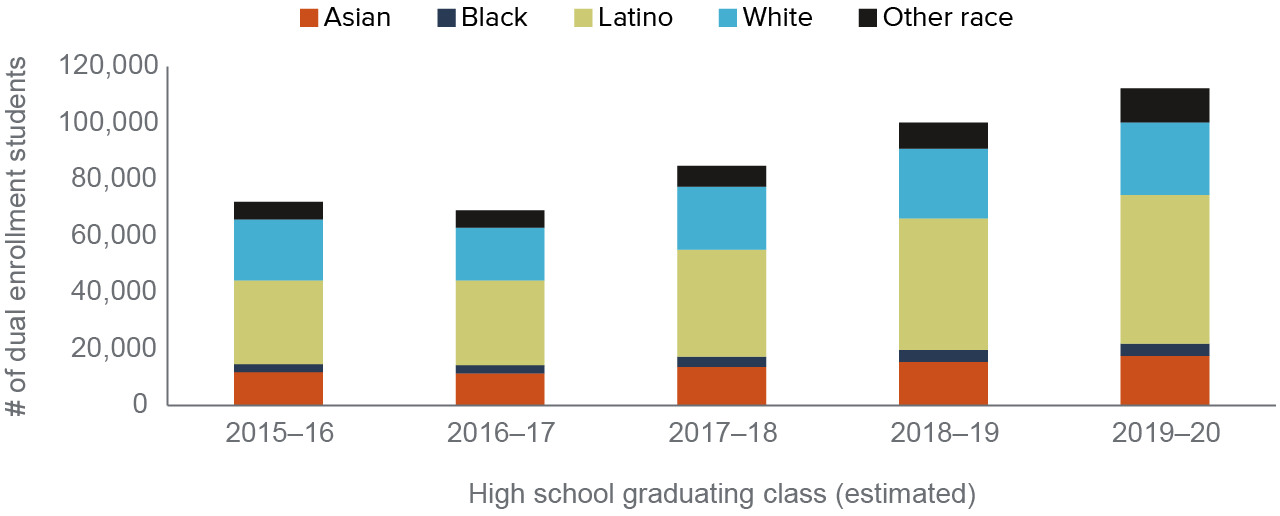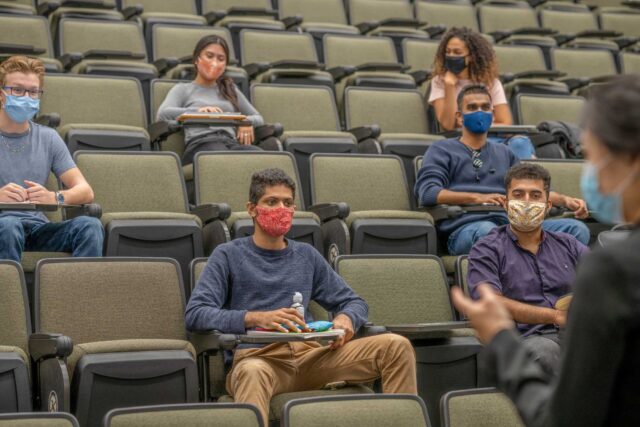Dual enrollment provides opportunities for high school students to take college courses and earn college credit. The COVID-19 pandemic has fueled a surge in participation across the country, and equity-centered legislation has raised dual enrollment’s profile in California. Because California’s public K–12 schools serve large shares of students from groups that have been historically underrepresented in higher education, increasing equity and success in these programs is critical to expanding educational opportunities, improving economic mobility, and meeting California’s need for skilled workers.
Dual enrollment at community colleges is having a growing impact—but there are gaps and challenges
All community colleges offer some form of dual enrollment, and more than 112,000 high school students graduating in the 2019–20 school year participated—an increase of 56 percent from 2015–16. This growth has been partly driven by the launch of College and Career Access Pathways (CCAP) in 2016 and higher Latino student participation.
Participation in dual enrollment at community colleges has been growing

SOURCE: COMIS, 2012–13 through 2019–20.
NOTES: Sample includes 438,417 high school graduates from 2015/16–2019/20 who enrolled in at least one community college course as “special admit” students between 2012/13 and 2019/20. We do not have high school information for most “special admit” students, so we estimate their high school classes based on the age at which they took a first dual enrollment course. We rely on California Department of Education enrollment information, which is based on grade and age, to estimate time of graduation (assuming a four-year timeframe). Our sample also includes students in home school and private high schools; therefore, the number is higher than recent research by Wheelhouse.
Our descriptive findings indicate that dual enrollment students enroll in two- and four-year colleges at relatively high rates after they graduate from high school. Forty-four percent of recent dual enrollment students enrolled in two-year colleges, compared to 36% of all high school graduates; 37% enrolled in four-year colleges, compared to 26% of all graduates.
CCAP students are especially likely to enroll in two-year colleges—in line with the program’s goal of aligning K–12 and community college pathways. Other dual enrollment students are more likely to go to four-year colleges.
Despite its apparent success in boosting college enrollment, dual enrollment faces key gaps and challenges.
- Dual enrollment participation and outcomes vary across racial/ethnic groups. In general, white and Asian students are overrepresented, while Black and Latino students are underrepresented. But there are variations across programs: Latino students are equitably represented in CCAP, and Black students are well represented in other dual enrollment programs. Overall, Black and Latino students have lower dual enrollment GPAs and earn fewer units than Asian and white students.
- Some dual enrollment offerings do not grant college credit; these courses are not aligned with the goals of improving college completion and economic mobility. In addition, CCAP’s relatively large share of career education courses raises concerns about tracking low-income students and students of color into lower-paying vocations.
- Staffing shortages and instructor minimum qualifications are a key challenge. Stakeholders note that a big challenge to expanding dual enrollment is finding instructors who meet minimum qualifications. The difficulty is greater for academic courses such as English or math, for which instructors must have master’s degrees.
How can California improve and expand dual enrollment?
Our findings suggest several strategies for expanding dual enrollment opportunities across the state.
Align dual enrollment with college completion—and well-paying careers. To increase college graduation rates among Latino, Black, and low-income students, it is important to identify courses that help students make progress toward degrees and careers with living wages. Dual enrollment students who go to community college after high school could benefit from a dual admissions policy that would guarantee their admission to a four-year college.
Build on recent equity-centered legislation to improve access and outcomes. Recent legislation—including the creation of CCAP, the reform of math and English remediation at community colleges, and the adoption of an ethnic studies graduation requirement at CSU—represents a great opportunity to help underrepresented students earn college degrees. Research shows that both college gateway courses and ethnic studies have a positive impact. K–12 and college partners could help all high school students complete math, English, and ethnic studies general education requirements.
Consider restricting dual enrollment courses in remedial math and English. CCAP policy should restrict remedial math and English courses. Currently, CCAP programs are allowed to offer “innovative” remediation, and some colleges see CCAP as a way to retain remedial courses. However, this does not align with the goals of dual enrollment or recent remediation reforms, which have led community colleges to dramatically reduce (or eliminate) remedial course offerings since fall 2019.
Address instructor capacity issues. Many high school teachers do not have master’s degrees in their disciplines, and so cannot teach dual enrollment courses. One strategy—being implemented by Fresno’s K–16 Collaborative—is to support teachers pursuing master’s degrees in math and English. The community colleges should also reassess minimum qualifications: teaching experience—especially in AP/Honors courses—could be an alternative to a master’s degree.
Deploy a longitudinal student database to expand dual enrollment access and improve outcomes. California is building a longitudinal data system that connects its K–12, higher education, workforce, and social services systems. Such a system could promote equitable access to dual enrollment by lowering technological and logistical barriers. Longitudinal data could also inform efforts to improve student access and success and identify dual enrollment pathways that serve historically underrepresented students.
Topics
Access Completion Equity Higher Education K–12 Education Workforce NeedsLearn More

Testimony: Improving College Access and Success through Dual Enrollment

Making the Most of State Investments in Dual Enrollment

Improving College Access and Success through Dual Enrollment

Geography of Dual Enrollment Programs in California

Dual Enrollment Can Expand Educational Opportunity

Improving College Readiness through Dual Enrollment


